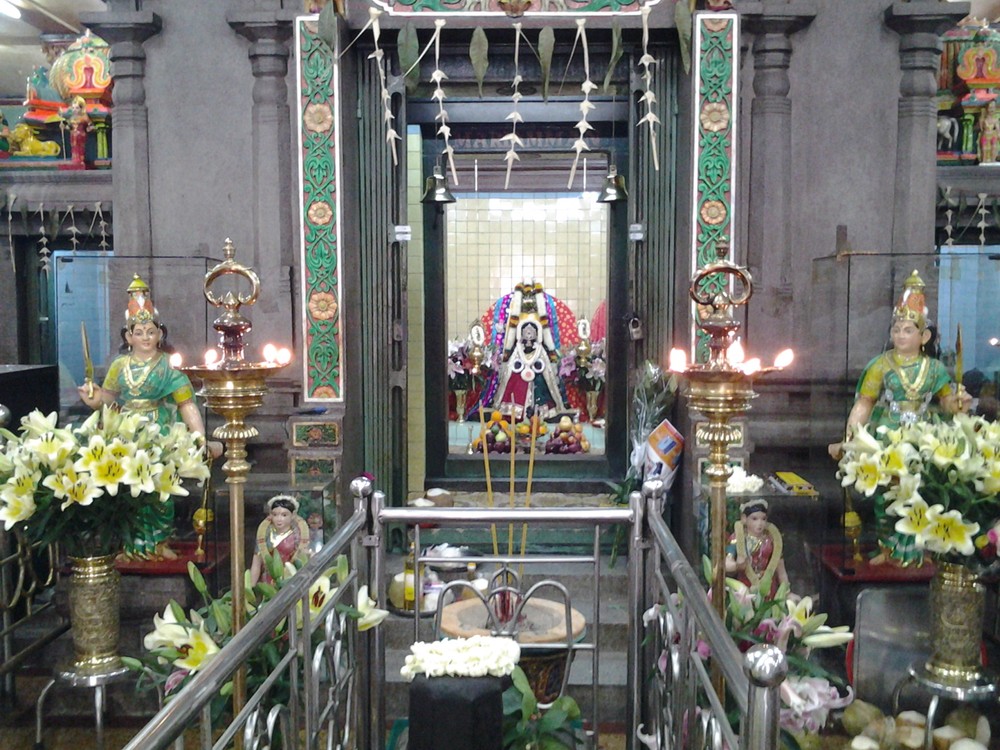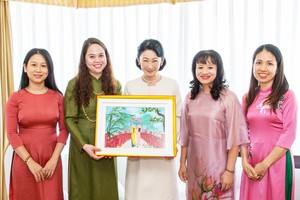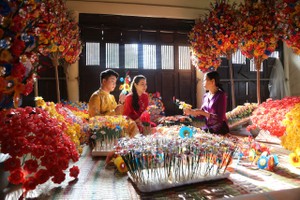
As an Indian, I too was delighted to see a beautifully carved ancient Hindu Temple in Saigon, that was not just another tourist monument, but an active place of veneration and worship, streaming with people of many nationalities, including a majority of Vietnamese, so devoutly praying in front of the deity, the very powerful Hindu Goddess Mariamman. In Saigon, the Vietnamese people refer to the temple as ‘Chua Ba Mariamman’.
When I first visited the Mariamman Temple on Truong Dinh Street in District 1, it came as a surprise to see so many devout Vietnamese people burning clusters of incense sticks and praying with heartfelt devotion for their wishes to come true. I was even more surprised when one Vietnamese lady told me she had come to the temple to thank the Goddess Mariamman for granting her desire to have a child after two years of marriage. She sincerely believed that coming to the temple regularly for the last few months had answered her prayers and she was able to conceive.
Temple built by South Indian Chettiar diaspora
The Chettiars are a mercantile community of Indian origin who traditionally are bankers and money lenders, and considered to be the real pioneers of modern day net banking. Their home turf lies in a place called Chettinad in the Province of Tamil Nadu in Southern India. The entire region of Chettinad comprises of a cluster of thousands of villages along the sea coast. They are a very close knit conservative community and devote a considerable amount of their time to religious activities. They follow a strict code of business ethics, and assure people of a good return on their investment. In the mid-19th century large groups of Chettiars traveled and traded widely in South East Asia, looking for new opportunities, which brought them to set up a base in Saigon. Vietnam’s sea line was luring and their trading enterprises flourished here, with many Chettiar even having their own ships.
This flourishing community worshipped the Goddess of rain, and built the Mariamman temple in the heart of Saigon in late 19th century, in the same area that they owned shops and warehouses for large scale trading of goods such as rice and salt.
I spoke with one priest in the Mariamman temple, whose ancestors had also been priests in this particular temple in Saigon since it was constructed more than a hundred years ago. He told of how the Chettiar community from south India had come to Indochina to trade and had built this Mariamman temple for their worship. Chettiars being devout Hindus, never ever began any financial dealings of the day without first receiving the blessings of Goddess Mariamman, known as the Goddess of Rain and protector of heat-giving diseases like chickenpox, smallpox and cholera. In this way, the Chettiars brought a slice of Hindu India to a foreign land and spread their culture, which today is a footprint of their legacy.
Structure of the Mariamman Temple
The entrance doorway of the outer wall of the Mariamman temple is towered by a twelve-meter-tall ornate ‘Gopuram’ featuring colorful statues of many different Hindu gods and goddesses. A ‘Gopuram’ is a tapering oblong structure over entrance doorways of Hindu temples meant to bring inside the temple complex all the energy that exists in living beings, similar to those seen on entrances to the Hindu Angkor Wat temples in Cambodia.
Inside the temple is a large square room and at the center is another room for the shrine of the main deity, the Goddess Mariamman. The clothes of the Goddess are embroidered and festive, and she is symbolized with several arms, holding a knife, a shield, a drum, a bell, a devil's head, and a three-pronged fork. At the gate of the shrine two goddesses stand as guardian protectors of the deity, on either side. On the left stands goddess Mawaiveeran, and on the right is goddess Pechiamman. Two Shiva lingams on the front platform symbolize generative powers, and offer protection to women in time of fertility. In a relief above the shrine the goddess is shown in a seated position flanked by the gods Ganesha and Naaga.
Because Goddess Mariamman was also known as the goddess of the universe having many forms, the inner walls of the temple have a multitude of intricately carved statues representing the goddess in her various avatars of several gods and goddesses.
In a legend posted inside the temple walls, Goddess Mariamman is also worshipped as the healer of diseases such as smallpox. The story tells of a beautiful woman called Nagavali, who was the wife of one of the nine Rishis. Nagavali was famed for her beauty, and one day when the rishi was not at home the three-headed god Trimurti visited her but Nagavali ignored him and turned him out of her house. Trimurti was so angry that he cursed her by disfiguring her beautiful face. Nagavali became ugly with many pock marks on her face and body. When the rishi returned to his home he was shocked to find a disfigured wife and hating her looks, he threw her out of the house saying that she would surely be born as a demon in her next life and spread disease among people.
Nagavali left the house, and to survive she begged door to door for food, while fanning her body with margosa leaves to ward off the flies. Soon she was completely healed, and people from then on began to worship her as “Goddess Mari”, meaning “changed”, and having the miraculous powers of healing disease, and in particular, fertility in women.
Origins of Hindu Goddess Mariamman
In the southern parts of India, Goddess Mariamman is the main mother goddess of rain with her roots deeply embedded in the state of Tamil Nadu, a sea coast province in South India, although other states in South India also have highly prominent and intricately carved temples dedicated to her.
In North India, ‘Goddess Mariamman’ is seen as an incarnation of the Goddess Kali, with her north Indian counterparts being worshipped as Goddess Parvati and Goddess Durga.
Because Mariamman is the goddess of rain, her worshippers pray for her blessings on mankind for peace, prosperity and a bountiful harvest. She is believed to have miraculous powers to heal diseases such as smallpox and chickenpox as well.
In mid-July to mid-August, the ‘Aadi’ monsoon festival is held throughout Tamil Nadu, devoted entirely to goddess Mariamman. Aadi is a unique festival dedicated to all the perennial rivers and major lakes and the many water sources to celebrate the rising of the water levels in the monsoon season. This water ritual has been in practice since ancient times when it was patronized by kings and royal households.
‘Aadi’ is the month for sowing, rooting, planting of seeds and vegetation since it is peak monsoon time when rain is in abundance. During this time all worshippers of Goddess Mariamman mainly focus on her blessings for a productive rainy season, a bountiful harvest and for curing diseases like cholera, smallpox, and chicken pox.
In the South India regional language, Mariamman is also called ‘Muthu’ Mariamman, which means the goddess who gives prosperous rain. In the ancient usage of the language 'Muthu' signifies raindrops, and goddesses such as Mariamman are believed to protect villages and their lands and bring prosperity to all the people.
























